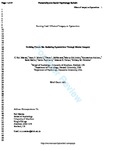Noticing Future Me
| dc.contributor.author | Macrae, CN | |
| dc.contributor.author | Mitchell, JP | |
| dc.contributor.author | McNamara, DL | |
| dc.contributor.author | Golubickis, Marius | |
| dc.contributor.author | Andreou, K | |
| dc.contributor.author | Møller, S | |
| dc.contributor.author | Peytcheva, K | |
| dc.contributor.author | Falben, JK | |
| dc.contributor.author | Christian, BM | |
| dc.date.accessioned | 2020-04-07T10:48:08Z | |
| dc.date.available | 2020-04-07T10:48:08Z | |
| dc.date.issued | 2016-07 | |
| dc.identifier.issn | 0146-1672 | |
| dc.identifier.issn | 1552-7433 | |
| dc.identifier.uri | http://hdl.handle.net/10026.1/15527 | |
| dc.description.abstract |
<jats:p>People drastically overestimate how often others attend to them or notice their unusual features, a phenomenon termed the spotlight effect. Despite the prevalence of this egocentric bias, little is known about how to reduce the tendency to see oneself as the object of others’ attention. Here, we tested the hypothesis that a basic property of mental imagery—the visual perspective from which an event is viewed—may alleviate a future-oriented variant of the spotlight effect. The results of three experiments supported this prediction. Experiment 1 revealed a reduction in egocentric spotlighting when participants imagined an event in the far compared with near future. Experiments 2 and 3 demonstrated reduced spotlighting and feelings of embarrassment when participants viewed an impending event from a third-person (vs. first-person) vantage point. Simple changes in one’s visual perspective may be sufficient to diminish the illusion of personal salience.</jats:p> | |
| dc.format.extent | 855-863 | |
| dc.format.medium | Print-Electronic | |
| dc.language | en | |
| dc.language.iso | eng | |
| dc.publisher | SAGE Publications | |
| dc.subject | egocentrism | |
| dc.subject | mental imagery | |
| dc.subject | prospection | |
| dc.subject | self | |
| dc.subject | visual perspective | |
| dc.subject | spotlight effect | |
| dc.title | Noticing Future Me | |
| dc.type | journal-article | |
| dc.type | Journal Article | |
| plymouth.author-url | https://www.webofscience.com/api/gateway?GWVersion=2&SrcApp=PARTNER_APP&SrcAuth=LinksAMR&KeyUT=WOS:000378530700002&DestLinkType=FullRecord&DestApp=ALL_WOS&UsrCustomerID=11bb513d99f797142bcfeffcc58ea008 | |
| plymouth.issue | 7 | |
| plymouth.volume | 42 | |
| plymouth.publication-status | Published | |
| plymouth.journal | Personality and Social Psychology Bulletin | |
| dc.identifier.doi | 10.1177/0146167216644961 | |
| plymouth.organisational-group | /Plymouth | |
| plymouth.organisational-group | /Plymouth/Faculty of Health | |
| plymouth.organisational-group | /Plymouth/Faculty of Health/School of Psychology | |
| plymouth.organisational-group | /Plymouth/REF 2021 Researchers by UoA | |
| plymouth.organisational-group | /Plymouth/REF 2021 Researchers by UoA/UoA04 Psychology, Psychiatry and Neuroscience | |
| plymouth.organisational-group | /Plymouth/REF 2021 Researchers by UoA/UoA04 Psychology, Psychiatry and Neuroscience/UoA04 Psychology, Psychiatry and Neuroscience MANUAL | |
| plymouth.organisational-group | /Plymouth/Users by role | |
| plymouth.organisational-group | /Plymouth/Users by role/Academics | |
| dc.publisher.place | United States | |
| dcterms.dateAccepted | 2016-03-23 | |
| dc.identifier.eissn | 1552-7433 | |
| dc.rights.embargoperiod | Not known | |
| rioxxterms.versionofrecord | 10.1177/0146167216644961 | |
| rioxxterms.licenseref.uri | http://www.rioxx.net/licenses/all-rights-reserved | |
| rioxxterms.licenseref.startdate | 2016-07 | |
| rioxxterms.type | Journal Article/Review |


